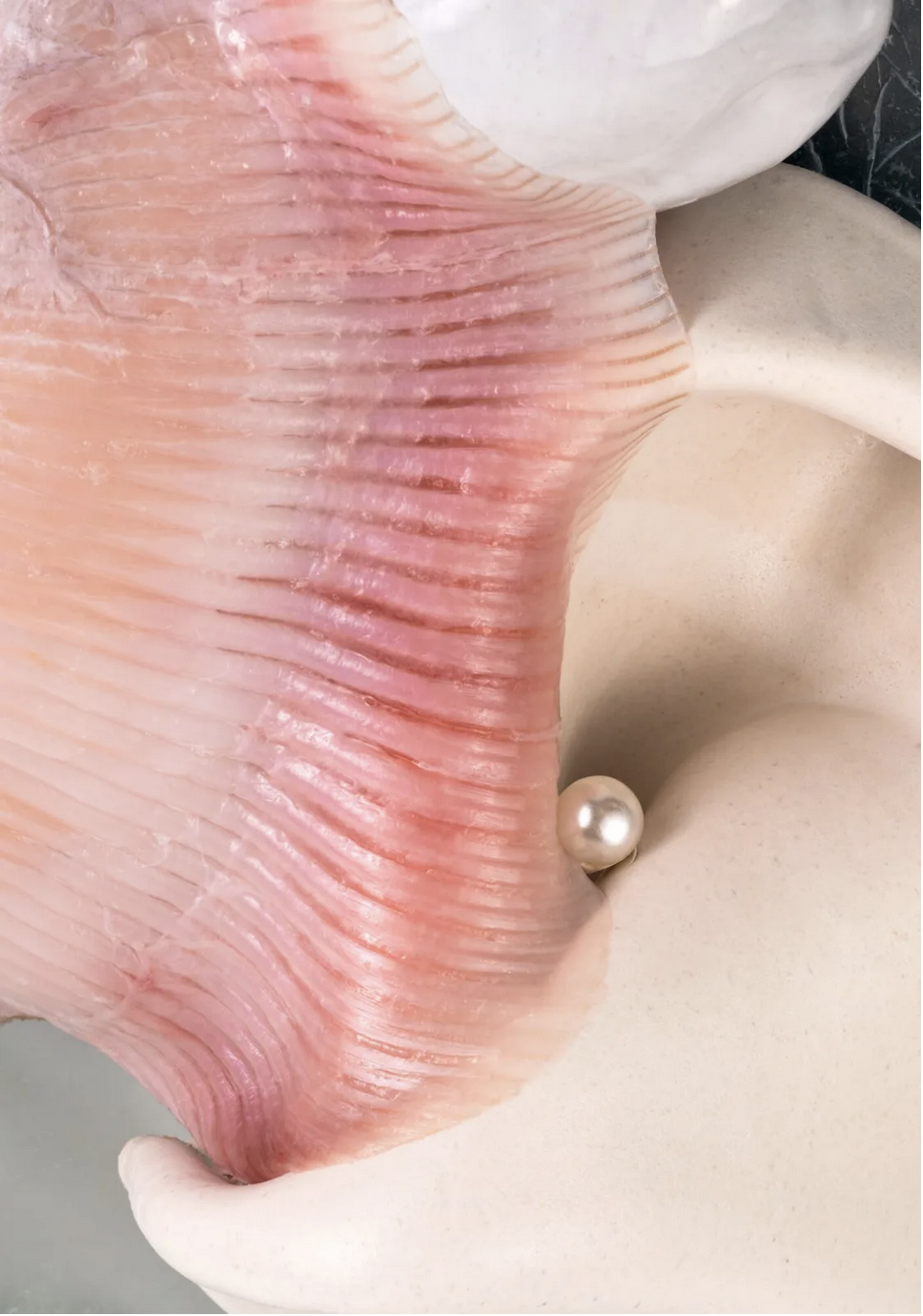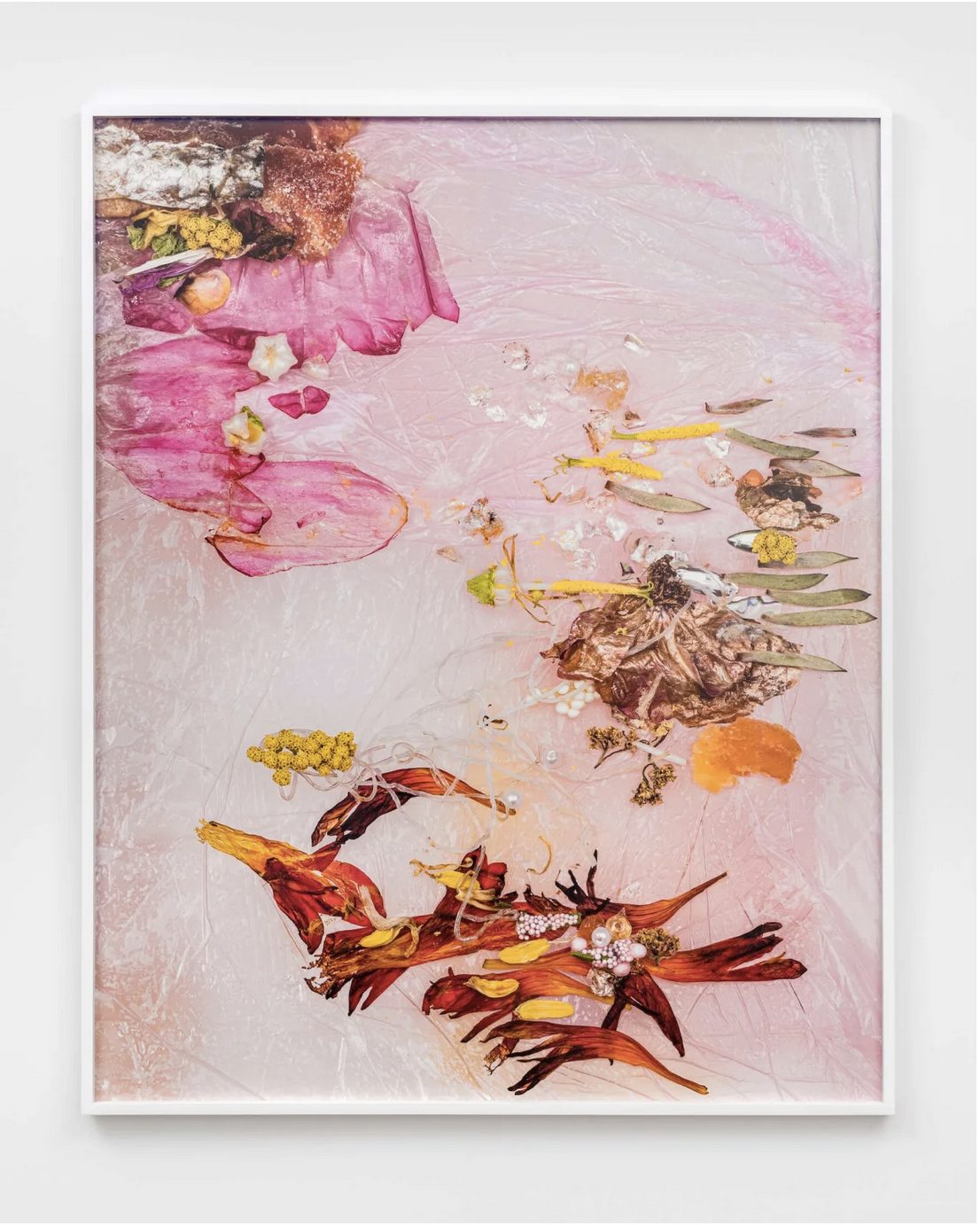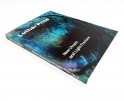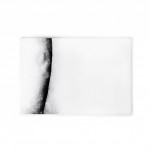Michelle Bui: Affinités poreuses

© Michelle Bui, Installation shot of “Affinités poreuses,” at McBride Contemporain. Photo by McBride Contemporain.
Upon viewing Michelle Bui’s showcase, “Affinités poreuses,” at McBride Contemporain last October, I was deeply moved. The large-scale images with vibrant color palette and textures struck a chord, delving into the remnants of overconsumption that defines our contemporary culture. This exploration aligns closely with my own photographic interests, forging my immediate bond with these images. Michelle’s photographs, simultaneously sensual and unsettling, immediately piqued my curiosity about her creative process. I reached out to Michelle and she graciously discussed her photographic journey, previous ventures with three-dimensional materials, and her multisensory approach to crafting her photographs. Below is a selection of the questions I posed to Michelle post her exhibition, along with the enlightening responses she shared.
Michelle Bui is a Montreal-based artist whose practice includes photography, sculpture and installation. Recent solo exhibitions include Naked Excess, Esker Foundation, Calgary (2022); Mutable Matter, Contemporary Art Gallery, Vancouver (2022); Spilled Plenitude, Franz Kaka, Toronto (2020); Centerfold, Parisian Laundry, Montreal (2019); Plein Soleil, Circa, Montreal (2019); Pool of Plenty, Galerie de l’UQAM, Montreal (2018). Bui completed her MA at Université du Québec à Montréal and at Beaux-arts de Paris, and her BFA at Concordia University. Her work is included in numerous collections, including those of the Montréal Museum of Fine Arts, the City of Montreal, Hydro-Québec, RBC Art Collection, Scotiabank and TD Bank. She was the recipient of the 2022 Prix Pierre Ayot.
Follow Michelle Bui on Instagram: @bui.michelle
Sarah Knobel: Can you talk about your process with making photographs? You mentioned to me earlier how you first worked with ceramics and sculpture. How does your photo practice connect to your background in ceramics and sculpture?
Michelle Bui: I started my photographic process by way of ceramics. I was doing small, quick, tactile clay pieces that responded mainly to the desire of my hands. You could compare this to a warm up before a drawing session: doing scribbles, lines and curves to feel the weight of the hand as you focus and connect as much as possible to the medium all the while letting go of the unnecessary. No matter the technique, I’ve always been attracted to the materiality of the medium, the smell and lushness of oil paint, the satisfying feeling of your hands and brush that glide on the cool and smooth limestone surface for lithography. Your question brings up fond memories of my early art formation and reminds me of the pleasure I felt in touching material and that eventually led to the desire to create a language for myself.
I’ve always enjoyed working with clay because it has the same directness as drawing, lithography or watercolor, which I’ve practiced before exploring ceramics. Of course clay can be extremely refined as we see with porcelain, but I was more interested in keeping the “warm-up” attitude and letting the material express itself without too much control on my part. I’ve often qualified this process as pre-language, a way of exploring and expressing a perception of the world without any expectation. This makes me think of a touching drawing I’ve recently seen by Stephen Schofield, called Sphere, that captures that playfulness and determination in discovering simple objects through their shape, weight, color, and taste. Sphere is a drawing of a baby’s clutch, which is such a wonderful way to express the idea of a beginner’s mind and the intense curiosity for the present which is a state of mind that I also try to cultivate in my practice. The result of this clay exploration was a series of fragile curved lines that resembled bones or bowels.
When the question of presentation arose, I was at that time worried about their frailty and meekness, and decided to photograph them and print the images of the sculptures as large as I could to give them more presence. I now think quite differently of those clay objects today and see strength in those humble stoneware though it prompted the beginning of my photographic practice.
SK: You’ve also mentioned smell a lot in our previous conversation. This is intriguing and something we usually don’t connect with photographic processes. Can you talk about this more?
MB: My work does play with the idea of smell as a stratagem to trigger my process, as a theoretical structure, and as a physical reaction that I hope to elicit in the viewer through the act of looking. Through the use of various objects and materials, I like to encourage confounding sensations that arise through these associations as a way to pay closer attention to the objects and things that surround us and that often escape our view. Viewers of my work are sometimes surprised with those compositions, but friction is very much part of our daily life. I often refer to the closest corner grocery store to my house I go too regularly which hits you with a bouquet of discordant smells before you even step into the door with a mix of off-gassing plastics from the imported kitchenware and knick-knacks, the drippings from the BBQ and deli counter, the bleach and salt of the fish section, the overripe tropical fruits and vegetables. Curiously, once you pass the tableware section, it’s the meat counter that has almost no smell at all, but it’s easy to anticipate the smell of the various flesh and offals once out of their refrigerators.
Ordinary experiences and gestures, like grocery shopping, cooking, tending the garden, walking around the city, etc. often end up in my work and perhaps this is why I really enjoy the writing of Deborah Levy as she never denigrates domestic, family life, while at the same time maintaining a constant dialogue between art and life. While my artwork is essentially visual, I actually enjoy that it relies only on the sense of seeing. Artists in particular have long been aware of these possibilities but I read that recent studies in neuroscience confirms that our apprehension of reality mobilizes kinesthetic capacities, i.e. equivalences between our different senses. Sight stimulates areas of our brain associated with movement, sound, smell, etc. through empathy or analogy. So the void left by the other senses opens up a space for imagination for myself and the viewer in stimulating our minds into creating a smell or a feeling, that is more complex and captivating than reality itself. This is why I am drawn to richly coloured and textured images and the power of suggestion they hold. And while what we end up imagining cannot be turned into words, this act forces us to reconsider our experience, and perhaps encourages us to look at things a second time with fresh eyes.
SK: Your new work shown in your recent exhibit, Affinités Poreuses, has a new aesthetic approach compared to your past work. Instead of being set up like a traditional still life, it fills the composition with a new sensibility. Would you describe how this work came about? What were you thinking about as the work transitioned?
MB: The transition started a few years ago when I had strong mental images of my work and had to change my way of working to get closer to those ideals. Essentially I moved from the table top to the floor which might not sound very drastic when described, but this way of working has fueled my studio practice for many years now. I also felt a bit restricted by that way of working which involved sculptural aspects and the question of balance. The camera and post-production on the computer were becoming more and more present which helped me gain confidence on technical aspects, but removed me from the materiality and tactility of the process.
My earlier series were more at a distance from the subject, putting it on show, but the more it went, the closer I wanted to lose the idea of the center and get into the literal flesh of the materials. By tilting the subject into an all-over, I sensed I could address the question of material excess into an imagery without edges. Working on the floor allowed the materials to answer to their own physical qualities instead of being propped up, and as I kept working in that way, I was more inclined to letting the materials take their own form. I was experimenting with gelatin, water, textiles, crushing, boiling or cutting them up. As the work became more liquid and abstract, I was also allowing time for the materials to develop, dry up, or rot over a few weeks.
I’ve arrived at a point where I have better trust in the process and am much more open, playful, and observing the changes that happen within the glass plates in which the materials are layed. The series Affinités poreuses was processual, building the image of an element, object or material at a time in a level-headed way instead of the frenzied and emotional state I used to put myself in the past which I thought was necessary to create. Perhaps motherhood has changed me in that way. I’m not looking for grand gestures anymore and have more of a steady approach of small interventions made of unexpected associations and discrete events that build up into an image a little bit like a poem.
SK: I really connect with this idea of motherhood consciously and subconsciously changing the way we work. When I became a mother, my work became more visceral, and textures and aesthetics started to appear as I became more aware of my body. Is this the same for you, or how has motherhood played a role in your new work?
MB: It’s such a vast question to answer and I could go in so many directions and my thoughts on this evolve daily! I had lots of questions about being an artist and a mother before giving birth, and looked for wisdom from my friends who were recent mothers, and also read a lot of essays, fiction, and listened and read many interviews that dealt with the question of creativity and motherhood. I mentioned it before, but Deborah Levy’s living autobiography (as she calls it) has been enlightening, such as Ongoingness by Sarah Manguso, Baby on the Fire Escape by Julia Phillips, Rachel Cusk’s NYT article on Cecily Brown and Celia Paul and her essay A Life’s Work, Motherhood by Sheila Heti, and the short stories by Yiyun Lee to name a few.
As for my experience, I’ve never really had a full halt from the studio after giving birth as I kept working the series I had started for Esker or the CAG, so the continuity of thought and practice has been essential in allowing me to unfold my practice into new awareness rather then a feeling of rupture. And I can’t say at the moment if it’s lack of time and the unpredictability of my schedule that has in turn made me much more focused or if it’s pregnancy and its own cycle that has obliged me to take the back seat and simply trust the process, but it’s an attitude that has also guided my studio practice. There is less time, and really no point to doubt myself while at the studio. This has allowed me to fuss less about the rest and focus on the crux of it all.
SK: Can you talk about what is next for you? What are some projects you are working on?
MB: I’m working on various commissions right now, some private and others that will be part of public art, but since it’s all in development I can’t say too much. Other than that I am excited to present a series of six works from my still life series that I have done since 2019. It will be presented in the vitrines of Montreal’s Place de la Cité Internationale as public art for Art Souterrain in March 2024, curated by Heather Davis. We are also expecting a second child early this May so there is a lot to be enthusiastic about in 2024!
SK: Congratulations on the newest member of your family soon arriving! Lot’s of exciting things ahead! Your photographic process is playful and thoughtful, and I can’t wait to see how it evolves with all the new things 2024 has for you. All our readers that will be in Montreal in March – look out for Michelle’s large scale photographs at Montreal’s Place de la Cité Internationale.
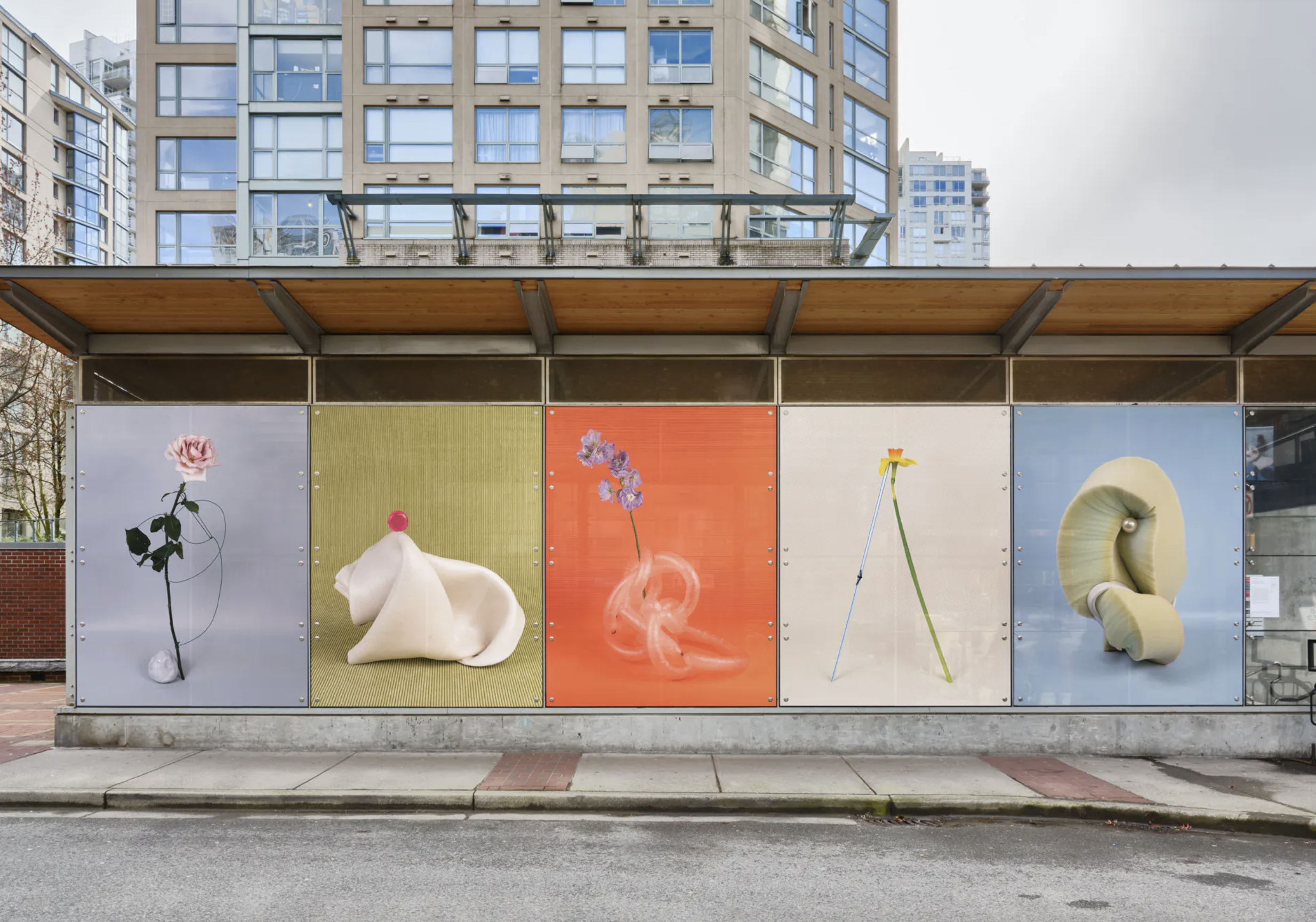
©Michelle Bui, installation view of Mutable Materialism, Yaletown-Roundhouse Station, Vancouver. Photo: Rachel Topham Photography.
Sarah Knobel is an artist captivated by the concept of commodities and their existence beyond mere utility. Through her evocative imagery, she crafts liminal spaces, inviting viewers to contemplate the enigmatic nature of everyday objects and our waste. Her work seamlessly weaves together optimism and hostility, beauty and repulsion, exploring the collision between the natural world and opposing forces.
Follow Sarah Knobel on Instagram at @sknobel
Posts on Lenscratch may not be reproduced without the permission of the Lenscratch staff and the photographer.
Recommended
-
Earth Week: Casey Lance Brown: KudzillaApril 25th, 2024
-
Earth Month: Photographers on Photographers, Dennis DeHart in conversation with Laura PlagemanApril 16th, 2024
-
Luther Price: New Utopia and Light Fracture Presented by VSW PressApril 7th, 2024
-
Artists of Türkiye: Eren SulamaciMarch 27th, 2024
-
European Week: Sayuri IchidaMarch 8th, 2024






